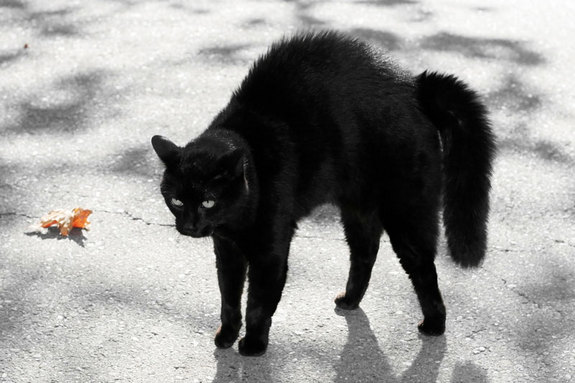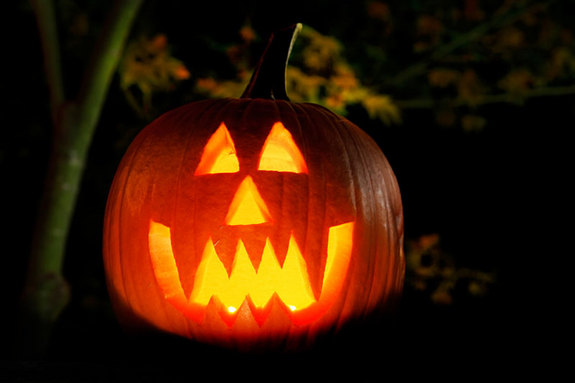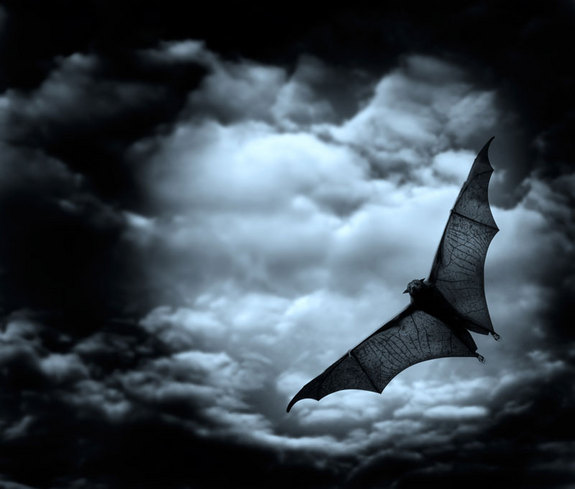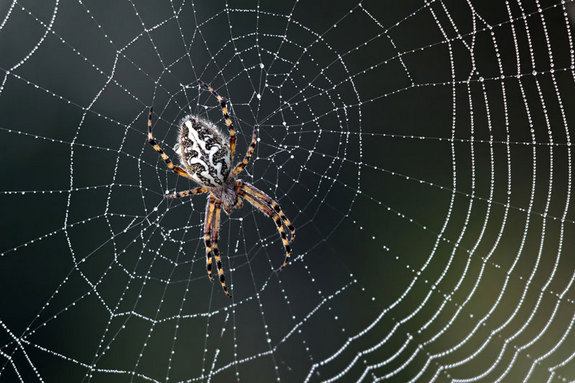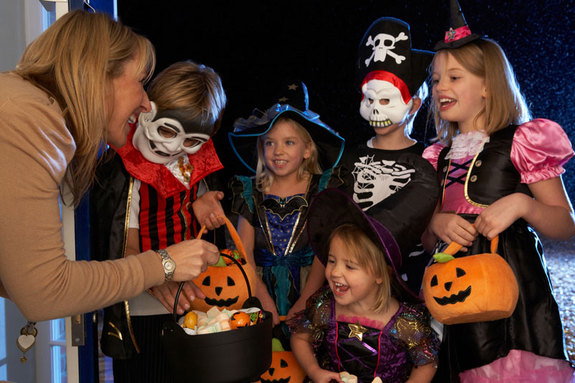On All Hallow's Eve…
Halloween may seem like it's all about costumes and candy, but the holiday — which is relatively new to America, having only become popular in the early 1900s — has its roots in pagan(异教徒) beliefs. Dating back about 2,000 years, Halloween marked the Celtic New Year and was originally called Samhain, which translates to "summer's end" in Gaelic(盖尔语).
Some Halloween traditions, such as carving Jack-o'-lanterns, are based on Irish folklore(民间传说) and have been carried on throughout the centuries, while others, such as candy corn, are more modern Halloween additions. Read on to find out the meaning behind 13 spooky(幽灵般的, 怪异的) Halloween staples(主要成分), including spiders, witches and trick-or-treatin
Black Cats
Often used as symbols of bad luck, black cats grace many Halloween decorations. The black cat's bad reputation dates back to the Dark Ages[黑暗时代(欧洲史上约为公元476-1000年)] when witch hunts were commonplace. Elderly, solitary(孤独的) women were often accused of witchcraft(魔法,巫术), and their pet cats were said to be their "familiars," or demonic animals that had been given to them by the devil.
Another medieval myth told that Satan turned himself into a cat when socializing with witches. But nowadays, black cats aren't synonymous with bad luck and mischief everywhere — in Ireland, Scotland and England, it's considered good luck for a black cat to cross your path.
Jack-O'-Lanterns
A fun fall activity, carving Jack-o'-lanterns actually has its roots in a sinister(邪恶的), tragic fable(寓言, 神话). Celtic folklore tells the tale of a drunken farmer named Jack who tricked the devil, but his trickery resulted in him being turned away from both the gates of heaven and hell after he died. Having no choice but to wander around the darkness of purgatory(炼狱), Jack made a lantern from a turnip(芜箐) and a burning lump(块) of coal that the devil had tossed him from hell.
Jack, the story goes, used the lantern to guide his lost soul; as such, the Celts believed that placing Jack-o'-lanterns outside would help guide lost spirits home when they wander the streets on Halloween. Originally made using a hollowed-out turnip with a small candle inside, Jack-o'-lanterns' frightening carved faces also served to scare evil spirits away. When the Irish potato famine of 1846 forced Irish families to flee to North America, the tradition came with them. Since turnips were hard to come by in the states at the time, pumpkins were used as a substitute.
Bats
Medieval folklore also described bats as witches' familiars, and seeing a bat on Halloween was considered to be quite an ominous(不吉利的) sign. One myth was that if a bat was spotted flying around one's house three times, it meant that someone in that house would soon die. Another myth was that if a bat flew into your house on Halloween, it was a sign that your house was haunted because ghosts had let the bat in.
Spiders
A common source of fear, spiders make for creepy, crawly(悚然的) Halloween staples. They join the ranks of bats and black cats in folklore as being evil companions of witches during medieval times. One superstition held that if a spider falls into a candle-lit lamp and is consumed by the flame, witches are nearby. And if you spot a spider on Halloween, goes another superstition, it means that the spirit of a deceased(已故的) loved one is watching over you.
Witches
The stereotypical image of the haggard(憔悴的) witch with a pointy(非常尖的) black hat and warty(疣, 肉赘) nose stirring a magical potion in her cauldron(大锅炉) actually stems from a pagan goddess known as "the crone," who was honored during Samhain. The crone was also known as "the old one" and the "Earth mother," who symbolized wisdom, change, and the turning of the seasons. Today, the kind, all-knowing old crone has morphed into the menacing(险恶的), cackling(咯咯笑) witch.
Cauldrons
The pagan Celts believed that after death, all souls went into the crone's cauldron, which symbolized the Earth mother's womb. There, the souls awaited reincarnation(再投胎), as the goddess' stirring allowed for new souls to enter the cauldron and old souls to be reborn. That image of the cauldron of life has now been replaced by the steaming, bubbling, ominous brew.
Witch's Broomstick
The witch's broomstick(帚柄) is another superstition that has its roots in medieval myths. The elderly, introverted women that were accused of witchcraft were often poor and could not afford horses, so they navigated through the woods on foot with the help of walking sticks, which were sometimes substituted by brooms.
English folklore tells that during night-time ceremonies, witches rubbed a "flying" potion on their bodies, closed their eyes and felt as though they were flying. The hallucinogenic(引起幻觉的) ointment(药膏, 油膏), which caused numbness, rapid heartbeat and confusion, gave them the illusion that they were soaring through the sky.
Trick-Or-Treating in Costumes
In olden times, it was believed that during Samhain, the veil between our world and the spirit world was thinnest, and that the ghosts of the deceased could mingle with the living. The superstition was that the visiting ghosts could disguise themselves in human form, such as a beggar, and knock on your door during Samhain asking for money or food. If you turned them away empty-handed, you risked receiving the wrath of the spirit and being cursed or haunted.
Another Celtic myth was that dressing up as a ghoul(食尸鬼) would fool the evil spirits into thinking that you were one of them so that they would not try to take your soul. In the U.S., trick-or-treating became a customary Halloween tradition around the late 1950s, after it was brought over by Irish immigrants in the early 1900s.
Halloween Colors
The traditional Halloween colors of orange and black actually stem from the pagan celebration of autumn and the harvest, with orange symbolizing the colors of the crops and turning leaves, while black marks the "death" of summer and the changing season. Over time, green, purple and yellow have also been introduced into the color scheme of Halloween decorations.
Mischief Night
From some — namely troublesome teenagers — Halloween is also a time for neighborhood pranks(恶作剧). From egging and toilet-papering houses to smashing jack-o'-lanterns, "devil's night" can be full of mischief(恶作剧) and menace.
The ancient Celts celebrated Samhain with bonfires, games and comical(好笑的, 滑稽的) pranks. By the 1920s and 30s, however, the celebrations became more rowdy(粗暴的), with rising acts of vandalism(恶意破坏的行为), possibly due to the tension caused by the Great Depression, according to Jack Santino's "Halloween and Other Festivals of Death and Life" (Univ. of Tennessee Press, 1994). To curb the vandalism, adults began to hand out candy, reigniting the forgotten tradition of trick-or-treating in costume in exchange for sweets. This successfully replaced most of the mischief elements from Oct. 31 celebrations, so the troublemakers instead adopted Oct. 30 as their official night to pull pranks and wreak havoc(造成严重破坏).
Candy Apples
Candy apples are popular Halloween treats, and the sugary fruit on a stick was handed out during the early days of trick-or-treating in North America — before concerns over unwrapped candy became an issue. Today, candy apples can be covered in caramel(焦糖) or chocolate with nuts, as well as in the classic, shiny red syrup(糖浆).
The fusion of Celtic and Roman traditions is behind Halloween's candy-apple staple. Samhain was around the time of the Roman festival honoring Pamona, the goddess of fruit trees. The goddess is often symbolized by an apple, so the fruit became synonymous with Samhain celebrations of the harvest.
Bobbing for Apples
In ancient times, the apple was viewed as a sacred fruit that could be used to predict the future. Bobbing for apples(咬苹果游戏) is one of the traditional games used for fortune-telling on Halloween night. It was believed that the first person to pluck an apple from the water-filled bucket without using their hands would be the first to marry.
If the bobber lucked out and caught an apple on the first try, it meant that they would experience true love, while those who got an apple after many tries would be fickle(无常的,易变的) in their romantic endeavors. Another myth was that if a girl put her bobbed apple under her pillow on Halloween night, she would dream about her future husband.
Candy Corn
The candy most synonymous with Halloween, candy corn was invented in the late 1880s and began to be mass-produced in the early 1900s. The original process for making candy corn was cumbersome(麻烦的) and time-consuming, as each color of syrup had to be heated up in large vats(大桶, 大缸) and carefully poured by hand into specially shaped molds.
But the yellow, orange and white candy — meant to resemble a corn kernel — was a huge hit and remains a popular part of Halloween to this day.



